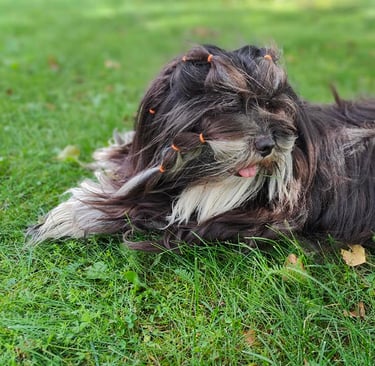The Genetic Cul-de-sac: A Dog's Tale of Evolution and Breeding
Welcome, dear readers, to the fascinating and sometimes bewildering world of dog genetics! Today, we're embarking on a journey through the genetic maze that has turned our beloved canine companions into designer dogs with a few quirks. Grab your leash and let's get started!
Laura Lhasafam
4/30/20252 min read


Dogs: The Original Opportunists
Why did dogs decide to hitch their fate to humans? Was it love at first sight or the promise of endless belly rubs? More likely, it was the allure of a full stomach. But as soon as dogs joined forces with humans, we took on a moral and ethical responsibility. Fast forward to today, and we've "improved" Canis familiaris into a genetic puzzle that sometimes struggles to whelp freely or even breathe correctly. Talk about unintended consequences!
The Origin Story: From Weasels to Wolves
Our story begins about 60 million years ago with a small weasel-like creature called Miacis. This ancestor of all modern canids didn't leave any direct descendants, but it did pave the way for Cynodictis, the first true dog-like canid. Fast forward to 100,000 years ago, and wolves started cozying up to humans. Whether it was the promise of leftover mammoth steaks or the thrill of the hunt, wolves and humans formed a bond that led to domestication. And so, the saga of man's best friend began.
Mutations: The Genetic Lottery
Mutations are like the genetic lottery—sometimes you win, sometimes you lose. These random changes in DNA can be caused by mistakes during replication or exposure to chemicals and radiation. Most mutations are harmful, but occasionally, they lead to beneficial traits. It's like playing a game of genetic roulette, and sometimes the odds are not in your favor.
Types of Mutations: The Good, the Bad, and the Ugly
Base-Pair Substitutions: Imagine swapping out a letter in a sentence and suddenly, "I love dogs" becomes "I loathe dogs." That's the kind of chaos a base-pair substitution can cause. If it results in a stop codon, the genetic message gets cut short, leading to problems like progressive retinal atrophy in Irish setters.
Frameshift Mutations: This is like adding or deleting a letter in a sentence, turning "The dog runs" into "The dgr uns." The result is often a very altered protein, leading to conditions like inherited anemia in Basenjis.
Splice-Site Mutations: Imagine a freight train that sometimes takes a detour to the wrong destination. That's what happens in Dobermans with von Willebrand disease. The defective switch sends the genetic train off the rails, causing a bleeding disorder.
Genetic Diversity: The Spice of Life
Genetic diversity is the spice of life, but dog breeders often prefer uniformity. To achieve the perfect "type," breeders have created highly inbred animals with multiple homozygous genes. Unfortunately, this has led to a plethora of genetic diseases. It's like trying to bake a perfect cake but ending up with a batch of cookies that crumble at the slightest touch.
Inbreeding: Walking a Genetic Tightrope
Breeders walk a tightrope between maintaining breed type and avoiding inbreeding depression. Too much inbreeding leads to homozygosity of deleterious alleles, resulting in fewer litters, smaller whelps, and failure to thrive. It's like trying to balance on a tightrope while juggling genetic mutations—one wrong move, and the breed faces extinction.
Bottlenecks: The Genetic Traffic Jam
Modern dog breeds have faced genetic bottlenecks, reducing their gene pools. World War II decimated giant breeds in Europe, creating a second, even more limited foundation for these breeds. Other bottlenecks occur when breeds become unpopular or when a few favored sires dominate the gene pool. It's like a genetic traffic jam, with only a few cars (genes) making it through.
Conclusion: The Genetic Maze
We've explored the origin of dogs, the role of mutations, and the dangers of inbreeding and bottlenecks. As breeders, it's our responsibility to navigate this genetic maze and ensure the health and future of our favorite companions. So hang on tight, because it's going to be a wild ride!
